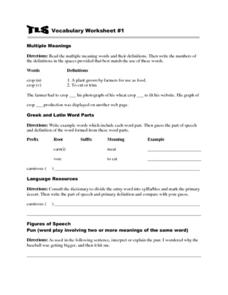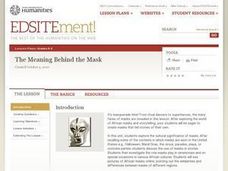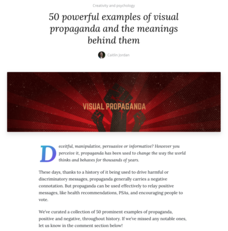Curated OER
It's All in the Way You Say It
High schoolers unearth multiple meanings based on connotation and cadence. After defining denotation, connotation, and cadence, readers evaluate similar words to compare connotations. They then play with how cadence affects meaning by...
Shmoop
ELA.CCSS.ELA-Literacy.L.11-12.5
"Timid, scared, terrified." High school scholars examine words, their denotations and connotations, in a series of exercises that use lines from Shakespeare to explore figurative language and word relationships. Participants then...
Curated OER
Analyzing Poetry with TPCASTT
Middle schoolers read a poem and complete a TPCASTT chart. They make a prediction about the title (T) , paraphrase each line (P), identify poetic devices and nuances (C-connotation), explore mood and tone (A-attitude), point out shifts...
Curated OER
Words That Sell
Explore words, definitions, their connotations and associations with brand names. Middle and high schoolers identify words used in commercials and determine their effect upon the consumer population. They explore how meanings are...
Curated OER
What is Terrorism?
Spark what's sure to be an interesting discussion in your classroom by introducing the topic of terrorism. Consider the meaning of the word terrorism and examine the associated connotations with a brief introductory reading. With your...
Shmoop
ELA.CCSS.ELA-Literacy.RL.9-10.4
The fourth standard for reading literature in the Common Core calls for young readers to be able to determine the figurative and connotative meanings of words and phrases. Use this resource, a continuation of a series of Common Core...
K20 LEARN
Things Are Lit at Thornfield: Jane Eyre
Jane Eyre offers scholars an opportunity to practice reading comprehension skills. Pairs are assigned a word from the text, use their prior knowledge, and consider the context, connotation, and denotation of the word to posit a...
K20 LEARN
It’s Raining Whats and Whats? Colloquial Language
"Yuns betta outten the lights!" Colloquial language is the focus of a lesson that asks middle schoolers to consider the pros and cons of using idioms. They read articles, match expressions with their meaning and place of origin, and...
Curated OER
Speak Write! Understanding the Hidden Meaning of Words
Students investigate connotation and denotation as a basis for greater examining of language. They identify the literal meaning of words and explore the greater implications and impact of word usage.
Curated OER
Understanding Connotation
Lincoln's "Gettysburg Address," which is available online, is used in the language instructional activity presented here. Middle schoolers read through the text for comprehension. Then, they reread the first paragraph and identify all...
Curated OER
Speech Acts
See various examples of connotations in phrases and semantics. Speech acts are displayed along with their contexts and meanings.
California Federation of Chaparral Poets, Inc
Poetic Devices
Have everything you need to know about the elements of poetry with a nine-page handout. Split into four categories—word sounds, meanings, arrangement, and imagery—budding poets may reference terms, read definitions, descriptions, and...
Curated OER
Literary Terms
Seriously, 93 slides of literary terms? Yes, and well worth the time, although perhaps not all at once. The beauty here is in the concise, easy-to-understand definitions for such well-known terms as imagery and personification, as well...
Overcoming Obstacles
Listening Critically
Eschew obfuscation!! High schoolers learn techniques that permit them to listen critically, sort through verbiage used to hide meaning or mislead listeners, and determine the message's validity.
Texas Education Agency (TEA)
Cognates (English III Reading)
Did you know that "30-40 percent of all words in English have a related word in Spanish?" This fact launches an interactive study of cognates appearing the same in English and Spanish. Learners demonstrate what they have learned about...
Curated OER
Sort Positive and Negative Words
Your learners distinguish words with positive connotations from those with negative connotations. They mark 25 words on a list with "P" for positive or "N" for negative to signify connotation. To extend, have them brainstorm words with...
Pennington Publishing
Vocabulary Worksheet #1 & #2
These two worksheets cover several grammatical topics. Pupils work on words with multiple meanings, Greek and Latin word parts, word connotations, academic language, and more. The result is seven quick exercises that could be used...
Curated OER
The Meaning Behind the Mask
Students explore the world of African masks and storytelling. They create masks that tell stories of their own.
Canva
50 Powerful Examples of Visual Propaganda and the Meanings Behind Them
Propagandists have many tools at their disposal to influence thinking and behavior. Among the most powerful are the visual tools, posters designed to grab the attention and stir the emotions of viewers. Check out this collection of...
Curated OER
Using Analogies to Improve Vocabulary
Ninth graders analyze the relationships for pairs of words in analogical statements to infer word meanings. In this word meanings lesson, 9th graders complete an analogy pre-assessment, study a chart for using analogies to improve...
Polk Bros Foundation
Punctuation Signals
Choose any passage that uses punctuation effectively and analyze it with your class. Learners read the passage out loud once, ignoring the punctuation. Then they read it again, but this time paying attention to all of the punctuation....
Curated OER
History of the Star Spangled Banner
We have all heard the "Star Spangled Banner" at many points in our lives, but how often do we take the time to truly understand what the words of the national anthem mean to Americans? Don't miss this opportunity to examine the lyrics...
Curated OER
What Are the Advantages and Disadvantages of Conforming?
Dive into Arthur Miller’s The Crucible and determine what it means to conform in society, and discuss as a group with the thoughts and plans available in these documents. Included are multiple activities and brain targets that form the...
Prestwick House
Teaching Shakespeare: Sonnet 73
It's that time of year to consider how Shakespeare selects his images and structures his Sonnet 73 to develop the meaning of the poem. Class members examine the rhyme scheme, the indented lines, the conceit, and the images used in each...

























